A great progressive power metal album! More in allmusic
Κυριακή 31 Ιανουαρίου 2010
Σάββατο 30 Ιανουαρίου 2010
Judith beheads Holofernes
Η βιβλική ιστορία της Ιουδίθ (Βιβλίο της Ιουδίθ) έχει περίπου ως εξής: Ηταν μια όμορφη εβραία χήρα, η οποία ανέλαβε να σώσει την πόλη της, η οποία κινδύνευε από τα ασσυριανά στρατεύματα του Ναβουχοδονόσορα υπό την ηγεσία του στρατηγού του Ολοφέρνη. Αυτή κατόρθωσε να διεισδύσει στο στρατόπεδο, δήθεν ως πληροφοριοδότης των Ασσυρίων και να σαγηνέψει τον στρατηγό με τα θέλγητρά της και βρίσκοντας την κατάλληλη ευκαιρία, ενώ αυτός κείτονταν μεθυσμένος στη σκηνή του, τον αποκεφαλίζει και μαζί με την υπηρέτριά της παίρνουν το κεφάλι και το δείχνουν περιχαρείς στους συμπολίτες τους. Με το χαμό του αρχηγού τους τα στρατεύματα των Ασσυρίων διαλύονται και σώζεται η πόλη.
Αυτό το επεισόδιο έχει δώσει έμπνευση σε πολλούς πίνακες από την εποχή της Αναγέννησης μέχρι και σήμερα, με διάφορες απόψεις για αυτό. Είτε ο αποκεφαλισμός γίνεται σε πλήρη συνεργασία με την υπηρέτρια, είτε η Ιουδίθ είναι ντυμένη και με πολεμική στολή, είτε γυμνή ή ημίγυμνη στην προσπάθειά της να ξελογιάσει τον στρατηγό. Εδώ επιλέγω μερικούς από αυτούς που απεικονίζουν την δολοφονία του με τον πιο δραματικό τρόπο.
In the Book of Judith of Old Testament, the story revolves on Judith, a daring and beautiful widow, who is upset with her Jewish countrymen for not trusting God to deliver them from their foreign conquerors. She goes with her loyal maid to the camp of the enemy general, Holofernes, to whom she slowly ingratiates herself, promising him information on the Israelites. Gaining his trust, she is allowed access to his tent one night as he lies in a drunken stupor. She decapitates him, then takes his head back to her fearful countrymen. The Assyrians, having lost their leader, disperse, and Israel is saved. The account of the beheading of Holofernes by Judith is the subject of numerous depictions in painting and sculpture as a theme of sex and gory violence and of female power against males.
Early Renaissance images of Judith tend to depict her as fully dressed and de-sexualized. Later Renaissance artists, showed a more sexualized Judith, a "seducer-assassin": "the very clothes that had been introduced into the iconography to stress her chastity become sexually charged as she exposes the gory head to the shocked but fascinated viewer," in the words of art critic Jonathan Jones. (Wikipedia)
Παρασκευή 29 Ιανουαρίου 2010
William Blake's "Nebuchadnezzar"
 Ο "Nebuchadnezzar" του William Blake είναι η αναπαράσταση της τρέλας από την οποία καταλήφθηκε ο βασιλιάς της Βαβυλώνας Nebuchadnezzar II (Ναβουχοδονόσορας) , όπως περιγράφεται στο Βιβλίο του Δανιήλ στη Βίβλο, ως τιμωρία από το Θεό για την ματαιοδοξία του και τους διωγμούς και τα δεινά των Εβραίων που προκάλεσε. Κατά την περίοδο της παραφροσύνης του, που κράτησε 7 χρόνια, τριγυρνούσε στα τέσσερα, γυμνός, σε πλήρη εξαθλίωση, σαν ζώο και έτρωγε χόρτο σαν τα βόδια. Αυτή η απεικόνιση βγήκε σε κάμποσες εκδοχές, η πρώτη εμφανίστηκε έντυπη στο ποίημά του “The Marriage of Heaven and Hell”:
Ο "Nebuchadnezzar" του William Blake είναι η αναπαράσταση της τρέλας από την οποία καταλήφθηκε ο βασιλιάς της Βαβυλώνας Nebuchadnezzar II (Ναβουχοδονόσορας) , όπως περιγράφεται στο Βιβλίο του Δανιήλ στη Βίβλο, ως τιμωρία από το Θεό για την ματαιοδοξία του και τους διωγμούς και τα δεινά των Εβραίων που προκάλεσε. Κατά την περίοδο της παραφροσύνης του, που κράτησε 7 χρόνια, τριγυρνούσε στα τέσσερα, γυμνός, σε πλήρη εξαθλίωση, σαν ζώο και έτρωγε χόρτο σαν τα βόδια. Αυτή η απεικόνιση βγήκε σε κάμποσες εκδοχές, η πρώτη εμφανίστηκε έντυπη στο ποίημά του “The Marriage of Heaven and Hell”: "Nebuchadnezzar" is a colour print portraying the Old Testament Babylonian king Nebuchadnezzar II by William Blake. Taken from the Book of Daniel, the legend of Nebuchadnezzar tells of a ruler who through hubris lost his mind and was reduced to animalistic madness and eating "grass as oxen". Many versions have been made since its first appearance in “The Marriage of Heaven and Hell”
"Nebuchadnezzar" is a colour print portraying the Old Testament Babylonian king Nebuchadnezzar II by William Blake. Taken from the Book of Daniel, the legend of Nebuchadnezzar tells of a ruler who through hubris lost his mind and was reduced to animalistic madness and eating "grass as oxen". Many versions have been made since its first appearance in “The Marriage of Heaven and Hell”According to William Blake’s biographer Alexander Gilchrist, in this print the viewer is faced with the "a mad king crawling like a hunted beast into a den among the rocks; his tangled golden beard sweeping the ground, his nails like vultures' talons, and his wild eyes full of sullen terror. The powerful frame is losing semblance of humanity, and is bestial in its rough growth of hair, reptile in the toad-like markings and spottings of the skin, which takes on unnatural hues of green, blue, and russet." (Wikipedia)
Nebuchadnezzar II was a ruler of Babylon in the Chaldean Dynasty, who reigned between 605 BC and 562 BC. According to the Bible, he conquered Jerusalem, and sent the Jews into exile. He is credited with the construction of the Hanging Gardens of Babylon. He is featured in the Book of Daniel that discusses several events of his reign, in addition to his conquest of Jerusalem.
While boasting over his achievements, Nebuchadnezzar is humbled by God. The king loses his sanity and lives in the wild like an animal for seven years (by some considered as an attack of the madness called clinical lycanthropy or alternately porphyria). After this, his sanity and position are restored and he praises and honors God.
A clay tablet in the British Museum describes Nebuchadnezzar's behavior during his insanity: "His life appeared of no value to him... then he gives an entirely different order... he does not show love to ... family and clan does not exist." There is no record of acts or decrees by the king during 582 to 575 BC. (Wikipedia)
Ετικέτες
art classic-medieval,
book illustrations,
William Blake
Πέμπτη 28 Ιανουαρίου 2010
William Blake's "The Ghost of a Flea" (1819-1820)
 Ο πίνακας αυτός είναι μια μινιατούρα διαστάσεων 21,4x16,2 cm και απεικονίζει το φάντασμα ενός ψύλλου όπως το φαντάστηκε ο Blake ή όπως το είδε, μια και ισχυριζόταν ότι έβλεπε πνεύματα και οπτασίες. Αυτό έγινε σε μια συνάντηση με έναν αστρολόγο ο οποίος πίστευε ότι καλούσε πνεύματα, αλλά δεν μπορούσε ο ίδιος να τα δει, οπότε κάλεσε το Blake που είχε αυτή την «ικανότητα». Σε μια τέτοια συνάντηση του είπε πως είδε το φάντασμα ενός ψύλλου και του το ζωγράφισε σε σκίτσο εκείνη την ώρα. Αργότερα επεξεργάστηκε περισσότερο το σκίτσο και προέκυψε αυτός ο πίνακας που δείχνει πώς φαντάστηκε τον ψύλλο, ως ένα ανθρωπόμορφο κακόβουλο αιμοδιψές τέρας, αρκετά ανήσυχο και υπερκινητικό. Όπως είπε ο ίδιος ο Blake, είναι μια αλληγορία για τους ακόρεστους και αιμοδιψείς ανθρώπους, οι ψυχές των οποίων ξεπέφτουν στο επίπεδο ενός ψύλλου.
Ο πίνακας αυτός είναι μια μινιατούρα διαστάσεων 21,4x16,2 cm και απεικονίζει το φάντασμα ενός ψύλλου όπως το φαντάστηκε ο Blake ή όπως το είδε, μια και ισχυριζόταν ότι έβλεπε πνεύματα και οπτασίες. Αυτό έγινε σε μια συνάντηση με έναν αστρολόγο ο οποίος πίστευε ότι καλούσε πνεύματα, αλλά δεν μπορούσε ο ίδιος να τα δει, οπότε κάλεσε το Blake που είχε αυτή την «ικανότητα». Σε μια τέτοια συνάντηση του είπε πως είδε το φάντασμα ενός ψύλλου και του το ζωγράφισε σε σκίτσο εκείνη την ώρα. Αργότερα επεξεργάστηκε περισσότερο το σκίτσο και προέκυψε αυτός ο πίνακας που δείχνει πώς φαντάστηκε τον ψύλλο, ως ένα ανθρωπόμορφο κακόβουλο αιμοδιψές τέρας, αρκετά ανήσυχο και υπερκινητικό. Όπως είπε ο ίδιος ο Blake, είναι μια αλληγορία για τους ακόρεστους και αιμοδιψείς ανθρώπους, οι ψυχές των οποίων ξεπέφτουν στο επίπεδο ενός ψύλλου.William Blake first met astrologist John Varley in the autumn of 1818. Varley held a strong belief in the existence of spirits, but was frustrated by his inability to see them. Thus he was drawn to Blake, who claimed to have seen visions daily since when as a small child. The two would often gather late at night in Varley's house, and played a game in which Varley would attempt to summon the spirit of a historical or mythological person. On the appearance of the spirit, Blake would then attempt to sketch their likeness. In 1819, according to Varley, the imagery of a Flea came to Blake during one such meeting.
Ghost of a Flea, completed between 1819 and 1820, at 214 mm x 162 mm (painting) and 382 mm x 324 mm x 50 mm (frame), is a greatly reduced miniature portrait. Blake generally worked on a small scale, most of his illuminated pages, engravings and many of his paintings are only inches high. Although is one of Blake's smallest works, it is monumental in its imagination. In addition, its tidy scale creates a drama by contrasting the apparent muscular bulk and power of the creature against its incarnation as an insect in the panel.
The muscular and nude Flea is depicted using its jutting tongue to gorge on a bowl of blood. Part human, part vampire and part reptile, the beast strides from right to left between heavy and richly patterned curtains. In his left hand he holds an acorn and in his right a thorn, both items drawn from the tradition of fairy iconography. His massive neck is similar to that of a bull, and holds a disproportionally small head, marked by glaring eyes and open jaws, and a venomous slithering tongue. According to the art critic Jonathan Jones, the flea is depicted as an "evil, gothic, grotesque stalking through a starry realm between stage curtains." (wikipedia)
Blake's flea is evil, gothic, grotesque, stalking through a starry realm between stage curtains - walking the boards, in fact, as if the artist had ensnared this creature to appear in a spectacle. The ghost's spine is a throbbing, gristly column shooting into his scaly head with its bulging eyes and voracious tongue; his massive muscles are red-toned, as if infused with dried blood, and his loping, crushing walk is that of a colossus come to life. This vastness and mad-eyed bestiality contrasts with the visible form of the spirit's physical embodiment, which can be seen on the floor between his veined legs: a little flea.
Blake's explanation of the spirit he saw accords with the painting's extreme drama of scale, the contrast of the huge invisible monster with its tiny incarnation as insect. The blood-drinking household flea, said Blake, is in fact the physical shape taken by the souls of men who are so bloodthirsty that they are providentially confined to the size and form of insects. (guardian)
Τετάρτη 27 Ιανουαρίου 2010
Cannibalism in art: Cronus devouring his children
Two creepy paintings by famous painters about Cronus' (Saturn) myth who ate his children.
Ο πίνακας αυτός του Γκόγια είναι από τους πιο τρομερούς και μακάβριους σε όψη, δείχνοντας έναν Κρόνο σε κατάσταση κανιβαλιστικής παράκρουσης και τρέλας να καταβροχθίζει ένα ανθρώπινο σώμα. Ανήκει στους λεγόμενους Black paintings της πιο σκοτεινής περιόδου της ζωής του με έργα τα οποία τα έφτιαχνε μόνο για τον εαυτό του ενώ ήταν κλεισμένος στο σπίτι του, κάτω από μεγάλο ψυχικό στρες.
Ο πίνακας του Ρούμπενς, πιο συμβατικός και πιο κοντά στην αφήγηση του μύθου δείχνει έναν κακόβουλο γέρο να τρώει ένα βρέφος. Πολλοί όμως πιστεύουν ότι αυτός είναι ακόμα πιο τρομερός, γιατί ο πίνακας του Γκόγια απεικονίζει έναν τρελό σε στιγμή παράκρουσης, ενώ του Ρούμπενς έναν κακόβουλο και σαδιστή που έχει πλήρη συναίσθηση της πράξης του.
Εχουν διατυπωθεί και απόψεις που θέλουν τον πίνακα του Γκόγια να μην αναπαριστά τον Κρόνο, μια και το ανθρώπινο σώμα όχι μόνο δεν είναι βρέφους, αλλά οι καμπύλες του πιθανότατα να απεικονίζουν γυναικείο σώμα.
Πάντως και οι δυο πίνακες είναι εξίσου τρομεροί, ο καθένας με τον τρόπο του: από τη μια όπως αναφέρω πιο πάνω για το "ρεαλιστικό" έργο του Ρούμπενς, αλλά για το οποίο "αποστασιοποιημένοι" εμείς εκφράζουμε την απέχθειά μας απέναντι στον κακόβουλο γέρο, από την άλλη όμως, στο "εξπρεσιονιστικό έως σουρεαλιστικό" έργο του Γκόγια νοιώθουμε ένα τρόμο μέσα μας, σαν να γίνεται ο καθρέφτης κάποιας καταπιεσμένης τέτοιας παραφροσύνης στην άβυσσο της ψυχής μας που δεν θέλουμε να ξέρουμε τίποτε για αυτήν!!!
Perhaps the best known of Francisco Goya's Black Paintings is Saturn Devouring His Son, a disturbing portrait of Saturn . The frightening image portrays Saturn eating one of his children. Goya depicts this act of cannibalism with startling savagery. The background is black, while the limbs and head of Saturn seem to pop out of the shadows. Saturn's eyes are huge and bulging as if he were mad. His fingers dig into the back of his son, whose head and right arm are already consumed. Saturn is about to take another bite of his child's left arm. The only use of color besides flesh-tones is the splash of red blood covering the mutilated outline of the upper part of the partially-eaten, motionless body, which is chillingly depicted in deathly white. Goya may have been inspired by Peter Paul Rubens' 1636 picture of the same name.(wikipedia)
Rubens' painting is a brighter, more conventional treatment of the myth: his Saturn exhibits less of the cannibalistic ferocity portrayed in Goya's rendition. However, some critics have suggested that Rubens' portrayal is the more horrific: the god is portrayed as a calculating remorseless killer, who – fearing for his own position of power – murders his innocent child. Goya's vision, on the other hand, shows a man driven mad by the act of killing his own son. In addition, the body of the son in Goya's picture is that of an adult, not the helpless baby depicted by Rubens.
Goya had produced a chalk drawing of the same subject in 1796-7 that was closer in tone to Rubens' work: it showed a Saturn similar in appearance to that of Rubens', daintily biting on the leg of one of his sons while he holds another like a leg of chicken, with none of the gore or madness of the later work. Goya scholar Fred Licht has raised doubts regarding the traditional title however, noting that the classical iconographical attributes associated with Saturn are absent from the painting, and the body of the smaller figure does not resemble that of an infant. The rounded buttocks and wide hips of the headless corpse has also called into question the identification of this figure as a male. (wikipedia)
Ο πίνακας αυτός του Γκόγια είναι από τους πιο τρομερούς και μακάβριους σε όψη, δείχνοντας έναν Κρόνο σε κατάσταση κανιβαλιστικής παράκρουσης και τρέλας να καταβροχθίζει ένα ανθρώπινο σώμα. Ανήκει στους λεγόμενους Black paintings της πιο σκοτεινής περιόδου της ζωής του με έργα τα οποία τα έφτιαχνε μόνο για τον εαυτό του ενώ ήταν κλεισμένος στο σπίτι του, κάτω από μεγάλο ψυχικό στρες.
Ο πίνακας του Ρούμπενς, πιο συμβατικός και πιο κοντά στην αφήγηση του μύθου δείχνει έναν κακόβουλο γέρο να τρώει ένα βρέφος. Πολλοί όμως πιστεύουν ότι αυτός είναι ακόμα πιο τρομερός, γιατί ο πίνακας του Γκόγια απεικονίζει έναν τρελό σε στιγμή παράκρουσης, ενώ του Ρούμπενς έναν κακόβουλο και σαδιστή που έχει πλήρη συναίσθηση της πράξης του.
Εχουν διατυπωθεί και απόψεις που θέλουν τον πίνακα του Γκόγια να μην αναπαριστά τον Κρόνο, μια και το ανθρώπινο σώμα όχι μόνο δεν είναι βρέφους, αλλά οι καμπύλες του πιθανότατα να απεικονίζουν γυναικείο σώμα.
Πάντως και οι δυο πίνακες είναι εξίσου τρομεροί, ο καθένας με τον τρόπο του: από τη μια όπως αναφέρω πιο πάνω για το "ρεαλιστικό" έργο του Ρούμπενς, αλλά για το οποίο "αποστασιοποιημένοι" εμείς εκφράζουμε την απέχθειά μας απέναντι στον κακόβουλο γέρο, από την άλλη όμως, στο "εξπρεσιονιστικό έως σουρεαλιστικό" έργο του Γκόγια νοιώθουμε ένα τρόμο μέσα μας, σαν να γίνεται ο καθρέφτης κάποιας καταπιεσμένης τέτοιας παραφροσύνης στην άβυσσο της ψυχής μας που δεν θέλουμε να ξέρουμε τίποτε για αυτήν!!!
Perhaps the best known of Francisco Goya's Black Paintings is Saturn Devouring His Son, a disturbing portrait of Saturn . The frightening image portrays Saturn eating one of his children. Goya depicts this act of cannibalism with startling savagery. The background is black, while the limbs and head of Saturn seem to pop out of the shadows. Saturn's eyes are huge and bulging as if he were mad. His fingers dig into the back of his son, whose head and right arm are already consumed. Saturn is about to take another bite of his child's left arm. The only use of color besides flesh-tones is the splash of red blood covering the mutilated outline of the upper part of the partially-eaten, motionless body, which is chillingly depicted in deathly white. Goya may have been inspired by Peter Paul Rubens' 1636 picture of the same name.(wikipedia)
Rubens' painting is a brighter, more conventional treatment of the myth: his Saturn exhibits less of the cannibalistic ferocity portrayed in Goya's rendition. However, some critics have suggested that Rubens' portrayal is the more horrific: the god is portrayed as a calculating remorseless killer, who – fearing for his own position of power – murders his innocent child. Goya's vision, on the other hand, shows a man driven mad by the act of killing his own son. In addition, the body of the son in Goya's picture is that of an adult, not the helpless baby depicted by Rubens.
Goya had produced a chalk drawing of the same subject in 1796-7 that was closer in tone to Rubens' work: it showed a Saturn similar in appearance to that of Rubens', daintily biting on the leg of one of his sons while he holds another like a leg of chicken, with none of the gore or madness of the later work. Goya scholar Fred Licht has raised doubts regarding the traditional title however, noting that the classical iconographical attributes associated with Saturn are absent from the painting, and the body of the smaller figure does not resemble that of an infant. The rounded buttocks and wide hips of the headless corpse has also called into question the identification of this figure as a male. (wikipedia)
Ετικέτες
art classic-medieval,
Francisco Goya,
Peter Paul Rubens
Τρίτη 26 Ιανουαρίου 2010
Maxi single (12") : "Countdown", Band: Albert Jarvinen Band, featuring Lemmy on vocals (1984)
Albert Jarvinen (R.I.P) - the former guitarist of the Finnish rock'n'roll legends Hurriganes who has recorded several rock albums with various line-ups but this, the only recording of Albert Jarvinen Band, is the only one of them that can be labelled "hard rock". The thing that makes the record truly interesting is the fact that the vocalist is no other than Lemmy Kilmister (Motorhead) who has also produced the material. (isten.net)
The song "Countdown" was later included in a rare collective CD "Born To Lose - Live To Win (The Best Of Lemmy" (1994) among other Lemmy's participations in bands either as a member or as a guest. The instrumental "Heads off" was the B-side track of the original 1984 12" vinyl
The song "Countdown" was later included in a rare collective CD "Born To Lose - Live To Win (The Best Of Lemmy" (1994) among other Lemmy's participations in bands either as a member or as a guest. The instrumental "Heads off" was the B-side track of the original 1984 12" vinyl
19th century's Japanese surgical illustrations
 Πρόκειται για δυο απεικονίσεις χειρουργικών επεμβάσεων στην Ιαπωνία των αρχών του 19ου αι. σε μια διατριβή που ονομάστηκε Geka Kihai κι εκδόθηκε το 1851. Η διατριβή αυτή γράφτηκε και ζωγραφίστηκε από την Kamata Keishu, μαθήτρια του δημοφιλούς Ιάπωνα γιατρού Hanaoka Seishu, ο οποίος ήταν ο πρώτος γιατρός που εφάρμοσε γενική αναισθησία χρησιμοποιώντας βότανα για τις πρωτοπόρες χειρουργικές του επεμβάσεις.
Πρόκειται για δυο απεικονίσεις χειρουργικών επεμβάσεων στην Ιαπωνία των αρχών του 19ου αι. σε μια διατριβή που ονομάστηκε Geka Kihai κι εκδόθηκε το 1851. Η διατριβή αυτή γράφτηκε και ζωγραφίστηκε από την Kamata Keishu, μαθήτρια του δημοφιλούς Ιάπωνα γιατρού Hanaoka Seishu, ο οποίος ήταν ο πρώτος γιατρός που εφάρμοσε γενική αναισθησία χρησιμοποιώντας βότανα για τις πρωτοπόρες χειρουργικές του επεμβάσεις. Στην πρώτη εικόνα βλέπουμε την χειρουργική επέμβαση για αφαίρεση καρκινικού όγκου από το στήθος μιας 60χρονης το 1804, και στην άλλη ακρωτηριασμό ποδιού λόγω γάγγραινας. Σε πολλές τέτοιες δύσκολες επεμβάσεις χρησιμοποιούσε το πρώτο πετυχημένο αναισθητικό παρασκεύασμα από τα φυτά Ντατούρα και Ακόνιτο που ονομάστηκε Tsusensan.
Στην πρώτη εικόνα βλέπουμε την χειρουργική επέμβαση για αφαίρεση καρκινικού όγκου από το στήθος μιας 60χρονης το 1804, και στην άλλη ακρωτηριασμό ποδιού λόγω γάγγραινας. Σε πολλές τέτοιες δύσκολες επεμβάσεις χρησιμοποιούσε το πρώτο πετυχημένο αναισθητικό παρασκεύασμα από τα φυτά Ντατούρα και Ακόνιτο που ονομάστηκε Tsusensan.Πιο κάτω βλέπουμε μια απεικόνιση εξαγωγής όγκου από στήθος και τον εξαχθέντα όγκο σε ιατρικό εγχειρίδιο του 1818 που απεικονίζει τις μεθόδους του ίδιου γιατρού (Kikerabi Kiroku του Matsuzawa Kenshia).
These are illustrations from Geka Kihai, a surgical treatise by Kamata Keishu, who was the pupil od the famous Japanese Surgeon of early 19th century Hanaoka Seishu, who was the first who used general anaesthesia using a herbal mixture of Datura and Aconitum.
The first illustration shows the extraction of malignant tumour from the breast of a 60 years old patient in 1804. The second illustration shows the amputation of a leg with gangrene. By using this anaesthetic formula, named by him Tsusensan, he was able to perform many difficult operations like the above until his death in 1837.
Another surgical manuscript about Hanaoka Seishu's operations was Kikerabi Kiroku (Selected Case Reports of Surgical Operations) (1818) by Matsuzawa Kenshia, an illustration of this below where we see the extraction of tumour from breast (right) and the extracted tumour (left)
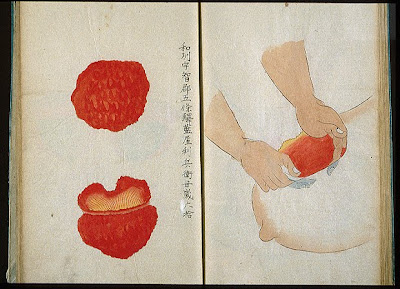 Information and photos were taken from Wikipedia, artinconnu.blogspot.com, welcome images,
Information and photos were taken from Wikipedia, artinconnu.blogspot.com, welcome images, imageofsurgery.com and US National Library of Medicine
Ετικέτες
art classic-medieval,
science
Δευτέρα 25 Ιανουαρίου 2010
Album: Practice what you Preach, Band: Testament (1989)
The most sociopolitical orientated album by Testament, one of their most sound accessible, and my favourite too. I like very much the cover of this album with ecological meanings: Earth is completely dry and dead, smog is everywhere, humans look like very sick and dehydrated, but still they feel arrogant and superior through their cultural achievements. More in wikipedia
Σάββατο 23 Ιανουαρίου 2010
Weird, yet true! They are dead!


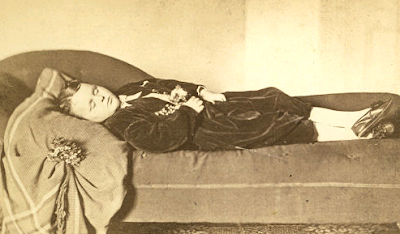

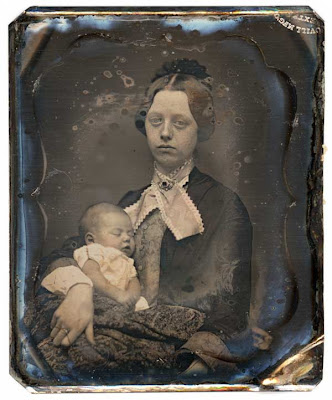
 Πρόκειται για μεταθανάτιες φωτογραφίες του 19ου αι., μια πολύ διαδεδομένη και προσφιλή συνήθεια εκείνη την εποχή που ο θάνατος ήταν ένα συνήθες και οικείο γεγονός μέσα στην καθημερινότητα, με την παιδική θνησιμότητα στα ύψη και τις διάφορες λοιμώδεις αρρώστιες να θερίζουν κόσμο και κοσμάκη αδιακρίτως ηλικίας και κοινωνικού στάτους, οπότε υπήρχε και μια άλλη σχέση των ανθρώπων με τον θάνατο από ό,τι υπάρχει σήμερα. Συνεπώς η επιθυμία μιας αναμνηστικής φωτογραφίας του εκλιπόντος αγαπημένου μέλους της οικογένειας, ειδικά αν ήταν βρέφος ή παιδί, αν ήταν δυνατό ντυμένου και περιποιημένου σαν ζωντανό, ήταν μια γλυκιά παρηγοριά κι ένα όμορφο αναμνηστικό του.
Πρόκειται για μεταθανάτιες φωτογραφίες του 19ου αι., μια πολύ διαδεδομένη και προσφιλή συνήθεια εκείνη την εποχή που ο θάνατος ήταν ένα συνήθες και οικείο γεγονός μέσα στην καθημερινότητα, με την παιδική θνησιμότητα στα ύψη και τις διάφορες λοιμώδεις αρρώστιες να θερίζουν κόσμο και κοσμάκη αδιακρίτως ηλικίας και κοινωνικού στάτους, οπότε υπήρχε και μια άλλη σχέση των ανθρώπων με τον θάνατο από ό,τι υπάρχει σήμερα. Συνεπώς η επιθυμία μιας αναμνηστικής φωτογραφίας του εκλιπόντος αγαπημένου μέλους της οικογένειας, ειδικά αν ήταν βρέφος ή παιδί, αν ήταν δυνατό ντυμένου και περιποιημένου σαν ζωντανό, ήταν μια γλυκιά παρηγοριά κι ένα όμορφο αναμνηστικό του. Σήμερα κάτι τέτοιο προκαλεί ανατριχίλα μια και έχουμε εξοβελίσει το θάνατο από την καθημερινότητά μας ή καλύτερα υποκρινόμαστε πως τον έχουμε εξοβελίσει, οπότε μια τέτοια συνήθεια μας φαίνεται αποκρουστική, μακάβρια και ιερόσυλη. Οσοι έχετε δει την ταινία «Οι Αλλοι» με την Νικόλ Κίντμαν, θα θυμάστε ότι αυτές οι φωτογραφίες αποτελούν σημαντικό στοιχείο της πλοκής της.
Σήμερα κάτι τέτοιο προκαλεί ανατριχίλα μια και έχουμε εξοβελίσει το θάνατο από την καθημερινότητά μας ή καλύτερα υποκρινόμαστε πως τον έχουμε εξοβελίσει, οπότε μια τέτοια συνήθεια μας φαίνεται αποκρουστική, μακάβρια και ιερόσυλη. Οσοι έχετε δει την ταινία «Οι Αλλοι» με την Νικόλ Κίντμαν, θα θυμάστε ότι αυτές οι φωτογραφίες αποτελούν σημαντικό στοιχείο της πλοκής της. Memorial postmortem photography was the common practice of taking a person’s portrait after they passed away. Since our culture now fears death more than we mourn it, these photos are seen today as macabre. But it was actually a beautiful tradition that helped families keep a small memento of the loved ones they had lost.
Memorial postmortem photography was the common practice of taking a person’s portrait after they passed away. Since our culture now fears death more than we mourn it, these photos are seen today as macabre. But it was actually a beautiful tradition that helped families keep a small memento of the loved ones they had lost.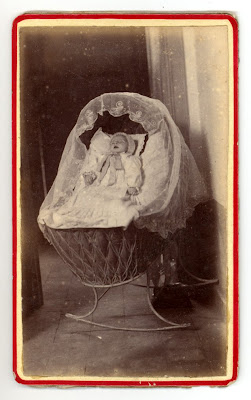 Death was more of an everyday occurrence in the 19th century than it is today. Infant mortality rates were terribly high, and diseases like tuberculosis, cholera and plain old infection killed many adults. In an age when hospitalization was uncommon, people died and were prepared for burial at home. Facing death often and at home meant that people were, if not less afraid of death than we are now, then at least more accustomed to it.
Death was more of an everyday occurrence in the 19th century than it is today. Infant mortality rates were terribly high, and diseases like tuberculosis, cholera and plain old infection killed many adults. In an age when hospitalization was uncommon, people died and were prepared for burial at home. Facing death often and at home meant that people were, if not less afraid of death than we are now, then at least more accustomed to it.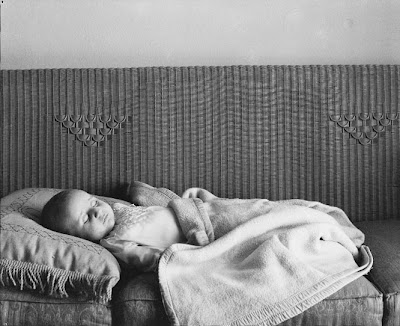 Memorializing a dead person in art is a custom that goes back centuries, but in the 1800s photography made post-mortem portraits available for the middle class. Though more affordable than having a portrait painted, photographs were still expensive and reserved for special occasions. In many cases, no photograph of the loved one existed before they died. Taking their portrait after death was a way to hold onto a visual remembrance.
Memorializing a dead person in art is a custom that goes back centuries, but in the 1800s photography made post-mortem portraits available for the middle class. Though more affordable than having a portrait painted, photographs were still expensive and reserved for special occasions. In many cases, no photograph of the loved one existed before they died. Taking their portrait after death was a way to hold onto a visual remembrance. The aim of a memorial portrait was often to make the person look as though they were still alive, only sleeping. Most of them show the deceased lying in bed, although some have them sitting up and holding flowers. A disturbing few show the deceased with their eyes open. The photographer would sometimes hand-color a rosy flush onto the person’s cheeks, and (in rare cases) even draw pupils onto closed eyelids.
The aim of a memorial portrait was often to make the person look as though they were still alive, only sleeping. Most of them show the deceased lying in bed, although some have them sitting up and holding flowers. A disturbing few show the deceased with their eyes open. The photographer would sometimes hand-color a rosy flush onto the person’s cheeks, and (in rare cases) even draw pupils onto closed eyelids. Since having a photograph taken was so expensive, many people economized by posing for a family portrait at the same time. Some photographers posed the parents or siblings with the departed family member, while others show the entire family at the funeral.
Since having a photograph taken was so expensive, many people economized by posing for a family portrait at the same time. Some photographers posed the parents or siblings with the departed family member, while others show the entire family at the funeral.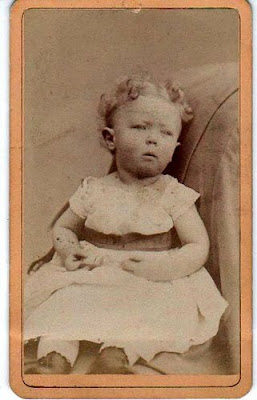 Once portable cameras became affordable, snapshot photography came into vogue. Having portraits of the living made post-mortem portraits unnecessary and undesirable. At the same time, the advent of antibiotics and vaccines lowered the death rate significantly. Instead of staying at home, people began to go to the hospital before they died. When death became less of an everyday matter, it became more alien and frightening. Although the practice of post-mortem portraiture persisted into the 20th century for some notable people, today it is largely perceived as morbid and creepy. (www.electronicsinfoline.com)
Once portable cameras became affordable, snapshot photography came into vogue. Having portraits of the living made post-mortem portraits unnecessary and undesirable. At the same time, the advent of antibiotics and vaccines lowered the death rate significantly. Instead of staying at home, people began to go to the hospital before they died. When death became less of an everyday matter, it became more alien and frightening. Although the practice of post-mortem portraiture persisted into the 20th century for some notable people, today it is largely perceived as morbid and creepy. (www.electronicsinfoline.com)




Παρασκευή 22 Ιανουαρίου 2010
Luis Royo, Epic-Gothic Fantasy art, Part 1
Luis Royo (born in 1954 in Olalla, Spain) is a Spanish artist, known for his darkly sensual paintings of women and mechanical life forms. He has also recently started doing sculptures of some of his earlier art. He was born in Olalla, a small town near Teruel, Spain. He has produced many paintings for his own books/exhibitions, and has also produced art for various other media: videogames, CD album covers, comic book covers, and Tarot cards. He is most famous for his work doing illustrations of Julie Strain for the animated movie Heavy Metal (www.madcowkaz.co.uk). Visit his site: www.luisroyo.com
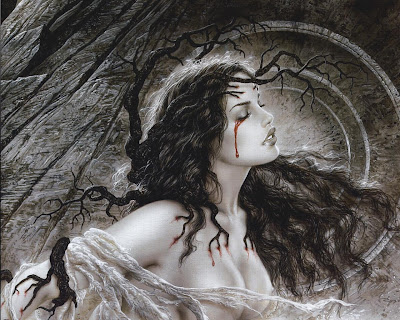
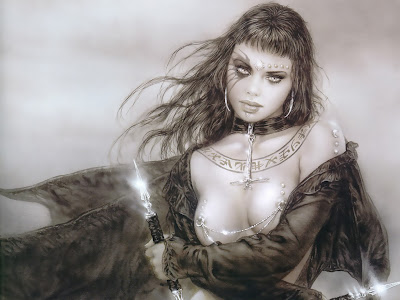


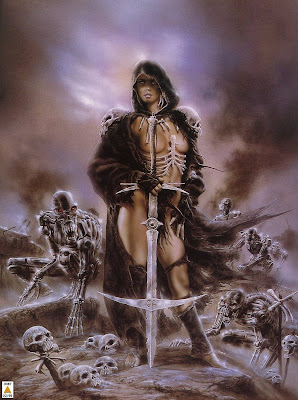



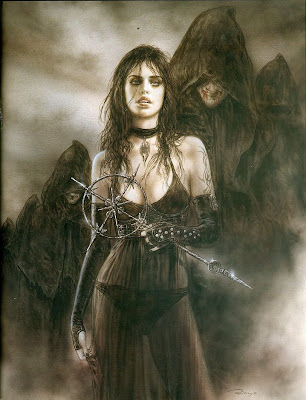
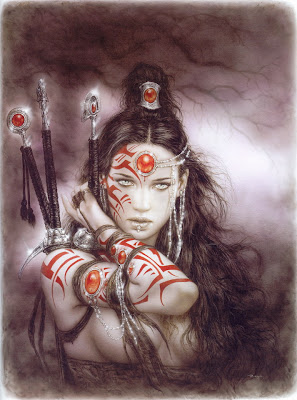













Πέμπτη 21 Ιανουαρίου 2010
Τρυπανισμός-Trepanning-Trephination
 Μία από τις αρχαιότερες επεμβατικές θεραπευτικές πρακτικές είναι ο τρυπανισμός των οστών του κρανίου, δηλαδή το άνοιγμα τρύπας σε αυτό κι έκθεση μέρους του εγκεφάλου στον αέρα, ενώ ο άνθρωπος ήταν ζωντανός. Οι λόγοι που το κάναν πιθανολογούνται από ανακούφιση από παθήσεις του κεφαλιού ή ακόμα και για πνευματιστικούς σκοπούς.
Μία από τις αρχαιότερες επεμβατικές θεραπευτικές πρακτικές είναι ο τρυπανισμός των οστών του κρανίου, δηλαδή το άνοιγμα τρύπας σε αυτό κι έκθεση μέρους του εγκεφάλου στον αέρα, ενώ ο άνθρωπος ήταν ζωντανός. Οι λόγοι που το κάναν πιθανολογούνται από ανακούφιση από παθήσεις του κεφαλιού ή ακόμα και για πνευματιστικούς σκοπούς.Κατά τον τρυπανισμό, που πρωτοεμφανίζεται στη Λίθινη εποχή (περί το 20 000 π.χ.) ανοίγονται οπές στα οστά του κρανίου πιθανότατα με σκοπό την απομάκρυνση των κακών πνευμάτων και την αντιμετώπιση ψυχικών διαταραχών, ημικρανιών ή της επιληψίας. Αρκετοί ασθενείς επιβίωναν του τρυπανισμού, όπως φαίνεται από τις οστικές ουλές που παρατηρούνται σε απολιθωμένα κρανία.
 Τα τρυπάνια που χρησιμοποίησε ο Νεολιθικός άνθρωπος στον τρυπανισμό του κρανίου είχαν ξύλινη λαβή και αιχμηρό άκρο από σκληρό υλικό, συνήθως το δόντι κάποιου ζώου ( π.χ. καρχαρία) ή κατάλληλα κατεργασμένη πέτρινη αιχμή.
Τα τρυπάνια που χρησιμοποίησε ο Νεολιθικός άνθρωπος στον τρυπανισμό του κρανίου είχαν ξύλινη λαβή και αιχμηρό άκρο από σκληρό υλικό, συνήθως το δόντι κάποιου ζώου ( π.χ. καρχαρία) ή κατάλληλα κατεργασμένη πέτρινη αιχμή. Συνηθισμένο ήταν επίσης το τόξο τρυπανισμού, που σχηματιζόταν από μία σκληρή ξύλινη λαβή γύρω από την οποία τυλιγόταν δερμάτινη χορδή. Ο θεραπευτής τοποθετούσε το αιχμηρό άκρο της λαβής στο κρανίο και κρατώντας το άλλο άκρο σταθερό περιέστρεφε το τρυπάνι με τη βοήθεια της χορδής. Με πιο εξελιγμένα εργαλεία και περισσότερη επιτυχία γίνονταν επεμβάσεις τέτοιου τύπου στην αρχαιότητα, στον Μεσαίωνα και την Αναγέννηση. Περισσότερα στο wikipedia
Συνηθισμένο ήταν επίσης το τόξο τρυπανισμού, που σχηματιζόταν από μία σκληρή ξύλινη λαβή γύρω από την οποία τυλιγόταν δερμάτινη χορδή. Ο θεραπευτής τοποθετούσε το αιχμηρό άκρο της λαβής στο κρανίο και κρατώντας το άλλο άκρο σταθερό περιέστρεφε το τρυπάνι με τη βοήθεια της χορδής. Με πιο εξελιγμένα εργαλεία και περισσότερη επιτυχία γίνονταν επεμβάσεις τέτοιου τύπου στην αρχαιότητα, στον Μεσαίωνα και την Αναγέννηση. Περισσότερα στο wikipedia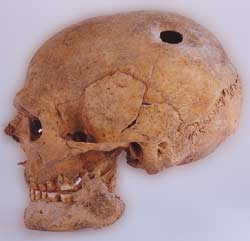 Trepanning, also known as trephination, trephining or making a burr hole, is a medical intervention in which a hole is drilled or scraped into the human skull, exposing the dura mater in order to treat health problems related to intracranial diseases.
Trepanning, also known as trephination, trephining or making a burr hole, is a medical intervention in which a hole is drilled or scraped into the human skull, exposing the dura mater in order to treat health problems related to intracranial diseases. Trepanned skull from ancient Greece. Στη Βέροια βρέθηκε σκελετός του 3ου μΧ αιώνος που φέρει οπή στο κρανίο από χειρουργική επέμβαση. Ο τρυπανισμός κρανίου αναφέρεται από τον Ιπποκράτη, τον Κέλσο και τον Γαληνό, αλλά τέτοια ευρήματα στον Ελλαδικό χώρο είνα σπάνια.
Trepanned skull from ancient Greece. Στη Βέροια βρέθηκε σκελετός του 3ου μΧ αιώνος που φέρει οπή στο κρανίο από χειρουργική επέμβαση. Ο τρυπανισμός κρανίου αναφέρεται από τον Ιπποκράτη, τον Κέλσο και τον Γαληνό, αλλά τέτοια ευρήματα στον Ελλαδικό χώρο είνα σπάνια.Trepanation is perhaps the oldest surgical procedure for which there is forensic evidence, and in some areas may have been quite widespread. Out of 120 prehistoric skulls found at one burial site in France dated to 6500 BC, 40 had trepanation holes. Many prehistoric and premodern patients had signs of their skull structure healing; suggesting that many of those subjected to the surgery survived.
Trepanation was also practiced in the classical and Renaissance periods. Hippocrates gave specific directions on the procedure from its evolution through the Greek age, and Galen also elaborates on the procedure.
During the Middle Ages and the Renaissance, trepanation was practiced as a cure for various ailments, including seizures and skull fractures. Out of eight skulls with trepanations from the 6th-8th centuries found in southwestern Germany, seven skulls show clear evidence of healing and survival after trepanation suggesting that the survival rate of the operations was high and the infection rate was low. (wikipedia)
Εγγραφή σε:
Αναρτήσεις (Atom)































.jpg)



